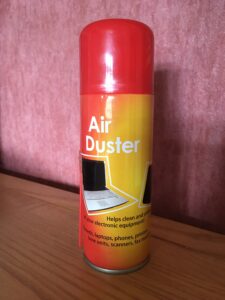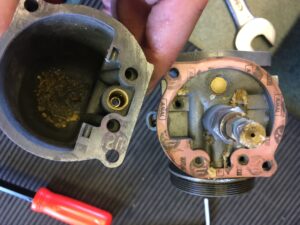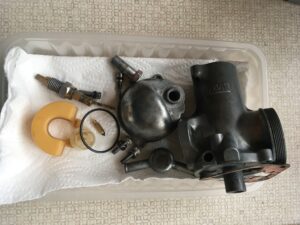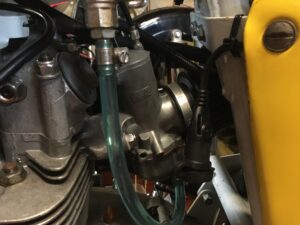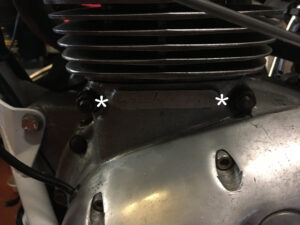Whilst I’d checked the bike over pretty thoroughly, I was under the impression the previous owner had done things like a clean out and service of the 928 concentric carburettor. Having made the front brake usable, I had a couple of successful rides just ’round the block’ with no issues, so I arranged a longer ride with a visit to a friend for a cuppa. The previous owner had been running the bike on Aspen fuel, but I put a gallon of premium E5 fuel in and headed off. All was well and the bike behaved impeccably until I was about six miles from home. The engine started to falter, then lost all power if I opened the throttle…I’d hoped to make it to my friend’s house just two miles away, but the bike was having none of it.
Once pulled over safely, I checked the ignition system and fuel, fuel filter, tank breather etc. There were no obvious problems and the bike would start but not stay running. Sadly, it was simply too cold to start stripping the carburettor etc, so I had to resort to recovery via my insurers, Carole Nash. They were of course closed on a Sunday, the on-line system said it ‘couldn’t complete the task right now’, and gave me the number of AXA to call for recovery. I’d added my bike to an existing policy almost two weeks previously, but Carole Nash hadn’t updated AXA. So, I had to pay for the recovery and the money will be refunded once they confirm my recovery insurance is valid. They sent a guy from SOS Motorcycle Recovery in Durham, who was fantastic. SOS also collect and deliver motorcycles for collectors, bikers and dealers…SOS Motorcycle Transport.
I suffer with Reynaud’s Syndrome if my fingers get too cold, so the bike was in the proverbial dog house for a couple of days until the cold snap from Iceland left to freeze someone else.
The first step was to remove the Amal 928 concentric carburettor. Once I drained it and took the float bowl off, the problem was immediately apparent. At some point the bike had been left standing, for quite some time by the look of it. There must have been a buildup of moisture in the float bowl from either condensation or more likely water dissolved in the ethanol in old petrol. When this happens, the water can react with the aluminium making up the float bowl, and create aluminium oxide. Once you remove it, you will see pitting in the bottom of the bowl. There was quite a large amount in my float bowl, some of it had become separated from the bowl, was floating free and would have blocked the jets…causing the breakdown.
There’s no point doing half a job, so the carburettor was removed, stripped and cleaned. The mixture screw and throttle stop were each screwed in and the turns counted, before removing them…it means you can put them back the way they were; mine were both one quarter plus three half turns. I’d reckon there was a good heaped teaspoon full of the oxide deposit. I cleared the jets out using a tin of compressed air; you can pay £15 for a small tin of this, or look around on-line where you can get three tins for £10. Make sure it has the thin tube on the side, as you’ll need to insert it into the nozzle to clear your jets.
It’s important to clear out all of the hard deposits or you may suffer the same fate again. I’m the owner of an ultrasonic cleaner, so I used that on the carburettor, with some detergent in the water, which was filthy once I’d finished. I then left the carburettor to dry overnight, before burnishing it with a small, soft, wire brush, on the end of an electric mini-drill; this gets rid of the matt finish without making the carburettor too shiny.
Both the mixture and throttle stop screws have a small o-ring on them, to form a good seal for the screw and to stop it vibrating loose. Both of mine were old and flat, so were replaced; Amal part number 622/082. The gaskets and other components were perfectly reusable. The fuel filter, part of the banjo housing, was also cleaned and inspected before being refitted.
Once the 928 carburettor was refitted, I decided to replace the rather chunky, black rubber fuel pipes. The pipe was opaque, very thick and difficult to compress with jubilee clips to stop it leaking…let alone using the cheap ‘finger squeeze’ type fitted. I used some blue, transparent, ethanol safe pipe and proper jubilee clips; now I can see what’s happening in the fuel lines.
Once I’d finished the carburettor cleaning, I noticed some oil on the side of the cylinder barrel. Investigation suggests that crankcase pressure can cause the oil to migrate up the studs that secure the head and barrel, and it then runs back down. This normally happens because the oil can make it passed the gasket, due to slight pressure in the crankcase. The best cure, apparently, is to use a Bunn Breather…but they are not available any more. I found the two nuts, on the left side of the engine, directly below the barrel, were not even finger tight.
These hold the crankcase halves together below the barrel and loose nuts may well be the cause of the oil leak…time will tell. Needless to say, I rechecked the rest of the nuts which were tight. If you have one of these bikes…it might be an idea to check your nuts are tight too! I’ve marked the nuts with a ‘*’ because I can only get the image editing software I use, to show a black arrow.
